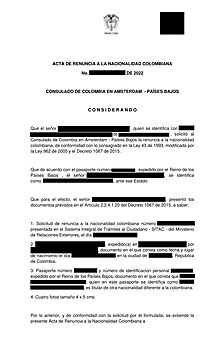Colombian nationality law
[3] A person who has lived in Colombia as a legal permanent resident for five years may apply for naturalization with the Ministry for Foreign Affairs.
[4] There are exceptions to the usual residence requirements in some cases, including: Applicants for naturalization must also pass a test on Colombia's history, geography and constitution.
The 1832 Constitution also granted nationality to the children of slave women who were covered by the Freedom of wombs laws.
[11][12] By the time the 1843 Constitution was adopted the language was specific, identifying nationals as adult men who had sufficient resources.
[13][Notes 1] In 1851 the legislature passed a law fully abolishing slavery in the territory which became effective on 1 January 1852.
[19] The constitution did not specifically address women in any of its articles, but excluded them from the right to citizenship and any benefits or obligations derived from nationality.
[27][Notes 2] Two rulings by the Ministry of Foreign Affairs, in the cases of Reyes Gnecco de Dugand (24 March 1888) and Emma Hulsman (1923), negated the requirement for married women to lose their nationality.
[14] Colombia passed exclusionary immigration laws beginning in 1922 which barred ethnic groups which were inconvenient for better racial development.
In 1935, the country instituted a quota system for immigrants limiting who could come from various countries, and in 1936 exorbitant fees and documentation were required for Bulgarians, Chinese, Egyptians, Estonians, Greeks, Hindus, Latvians, Lebanese, Lithuanians, Moroccans, Palestinians, Poles, Romanians, Russians, Syrians, Turks and Yugoslavs, as well as any Roma person regardless of their nationality.
[29] In 1933, Alfonso López and Raimundo Rivas, the Colombian delegates to the Pan-American Union's Montevideo conference, signed the Inter-American Convention on the Nationality of Women, which became effective in 1934, without legal reservations.
[30] Revisions to the Constitution in 1936 recognized some rights for women – access to education, limited administration of family assets, and some role in public duties – though it expressly stated only males over age 21 were citizens.
[34] Also in 1936, the Naturalization Law (Ley 22) was revised and Article 17 of the previous code, requiring unified family nationality, was repealed.


